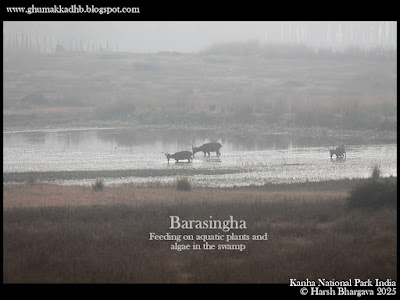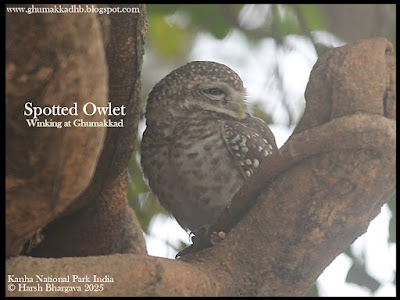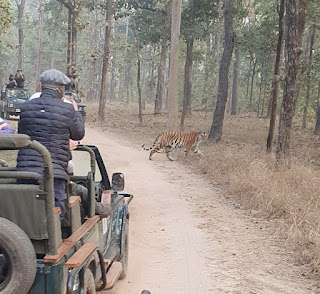'Can you identify the animal in the picture below?
'Yes, it is a deer.'
'Which deer?'
'Don't know.'
'It is a Barasingha. Have you seen it?'
'Oh yes, I have seen it in a zoo', is the common response. Was it your response too?
Well, Ghumakkad takes you to the swamps of Kanha, where Barasinghas thrive. Barasingha is the official mascot of Kanha National Park in Madhya Pradesh India.
Why this name?
Barasingha means 'having twelve antlers'. This deer species found in the Indian sub-continent, has twelve or more antlers. An antler is a bony mass with sharp ends which grow from the front of the head of a male deer. See the picture below of a Barasingha taken in Kanha.
The Coat
Barasingha males have a woolly coat yellowish brown in colour. In summer, the coat becomes bright rufous-brown. Females are paler than males. The males blend with the grassland around the swamps and can only be spotted with their antlers jutting out of the grass. See the picture below.
The Food
Barasinghas live in herds and feed on aquatic plants and algae. We saw them grazing in the morning around the swamps at a distance. See the pictures taken against the morning Sun. But the scene had its own charm. You don't always visit a forest for a good shot, but just to soak in its freshness, silence, whisper of the cool breeze, the scent of the jungle and an occasional call of a deer or a langur indicating the presence of a tiger somewhere around.
Population
According to Wikipedia, the total population of Barasingha in India is estimated to be between 3,500 and 5,100. It is found in three regions of India: Central, Northeast, and Northern India.
Sharing below few more animals spotted in Kanha. They are all part of the food chain.
Mutualism
We also observed a common mynah taking a joyride on a Barasingha. See the picture below.
This behaviour is common among many animal and bird species. According to the Encyclopedia of Ecology, Mutualism is defined as an interaction between individuals of different species that results in positive (beneficial) effects on per capita reproduction and/or survival of the interacting populations. You may browse our earlier story titled 'Mutualism by Nature' for details. Sharing below few pictures from that story.
Cattle Egrets and Mynahs with Buffaloes. PC Yella Prakash Rao
Nature continues to amaze if you have the patience to observe. Do take a walk in a garden, park, jungle or if you have the time, go on a hike in a forest. It is sure to rejuvenate you and recharge your life's batteries.
We are sharing below the links to our other three stories on Kanha and the life around the forest.
We were four of us who visited Kanha and Pench in January 2025. CP and Manik Srivastavas from Hyderabad, Debashish Mukherjee (Debu) from Kolkata and Ghumakkad also from Hyderabad, can be seen on the Safari vehicle at the breakfast spot in Kanha. Thanks are due to Debu and CP for sharing their pictures.
Hope you got a glimpse of the beauty of a forest, its flora and fauna. As Rudyard Kipling said, 'In the jungle, life and food depend upon keeping your temper'. We should respect the residents of the jungle. They have the right of way!
Thanks for browsing
- Harsh-the-Ghumakkad(Kanha Jan 2025)/ Posted 28th March 2025
#kanhanationalpark #kanhathemascot #barasingha #swampdeer #bhoorsingh #antlers #MPTourism #wildlife #wildlifephotography #madhyapradesh #ghumakkadhb #ghumakkadharsh #wwfindia






















Thank you Harsh for the interesting commentary
ReplyDeleteThanks Sir.
Delete
ReplyDeleteGreat narrative..and photos, Sir.
Thanks for sharing
Thanks for the company and your pictures CP and Manik
DeleteA very nicely written story with lovely pictures. Thanks for sharing.
ReplyDeleteThanks for your appreciation Asokan.
DeleteAptly captured various Flora & Fauna of Kanha forest, specially Barasingha. I have seen them in a zoo. Thanks for sharing these photos
ReplyDeleteThanks much for your feedback Capt Jindal. Appreciate.
DeleteNice trip to Kanha.
ReplyDeleteThanks.
DeleteNICE TRIP TO KANHA, THANK YOU FOR SHARING!
ReplyDeleteThanks much.
DeleteWhat a wonderful presentation! Thanks Harsh!!
ReplyDeleteIncidentally Air Force Station Tambaram is also a deer park; so many wild deer, that a bulk of them were shepherded to the Chennai zoo in an organised migration some 20 years ago. The remnants have grown into a sizeable number, so much so, that the technical area had to be fenced off to prevent them straying on to the runway. They are Cheetal mainly but i suspect quite a few are Barasingas.
Thanks Harsh for bringing up this subject. Ravi and Lakshmi
Thanks Ravi.
DeleteNext time you spot a deer there, do take a picture and share. It would be interesting to know if Barasinghas can thrive in the hot and humid coastal climate.
Indeed the Barasingha stag in rutting season with full grown antlers is a magnificent animal.
ReplyDeleteBarasingha and Nilgai are often seen in military stations. These herds would often be seen in front of our house at Bathinda Military Station (my last posting), wishfully eyeing Sangeeta's garden and vegetable patch.
After a successful raid by them one night having leapt over the 6 foot fence, we were forced to raise the fence to 9 feet height.
😉😂
Well recounted Jai. Yes, military stations are eco-friendly zones where flora and fauna of different varieties thrive. We have been lucky to live in such environs.
DeleteThanks for sharing your experience.
Nice pictures of wild life at Kanha National Park. You have high passion for travelling and looking at nature. You are excellent in tourism.
ReplyDeleteThanks much Jijaji.
DeleteGlad you liked it, thanks.
ReplyDeleteI really enjoyed going through your blog the way you’ve shared all informative on your blog Your content feels well-researched and genuinely helpful for wildlife lovers. I’ve also written about Nainital!I’ve shared insights on the best resort in Nainital and highlighted some details about the Nainital Lakeview Hote.
ReplyDelete